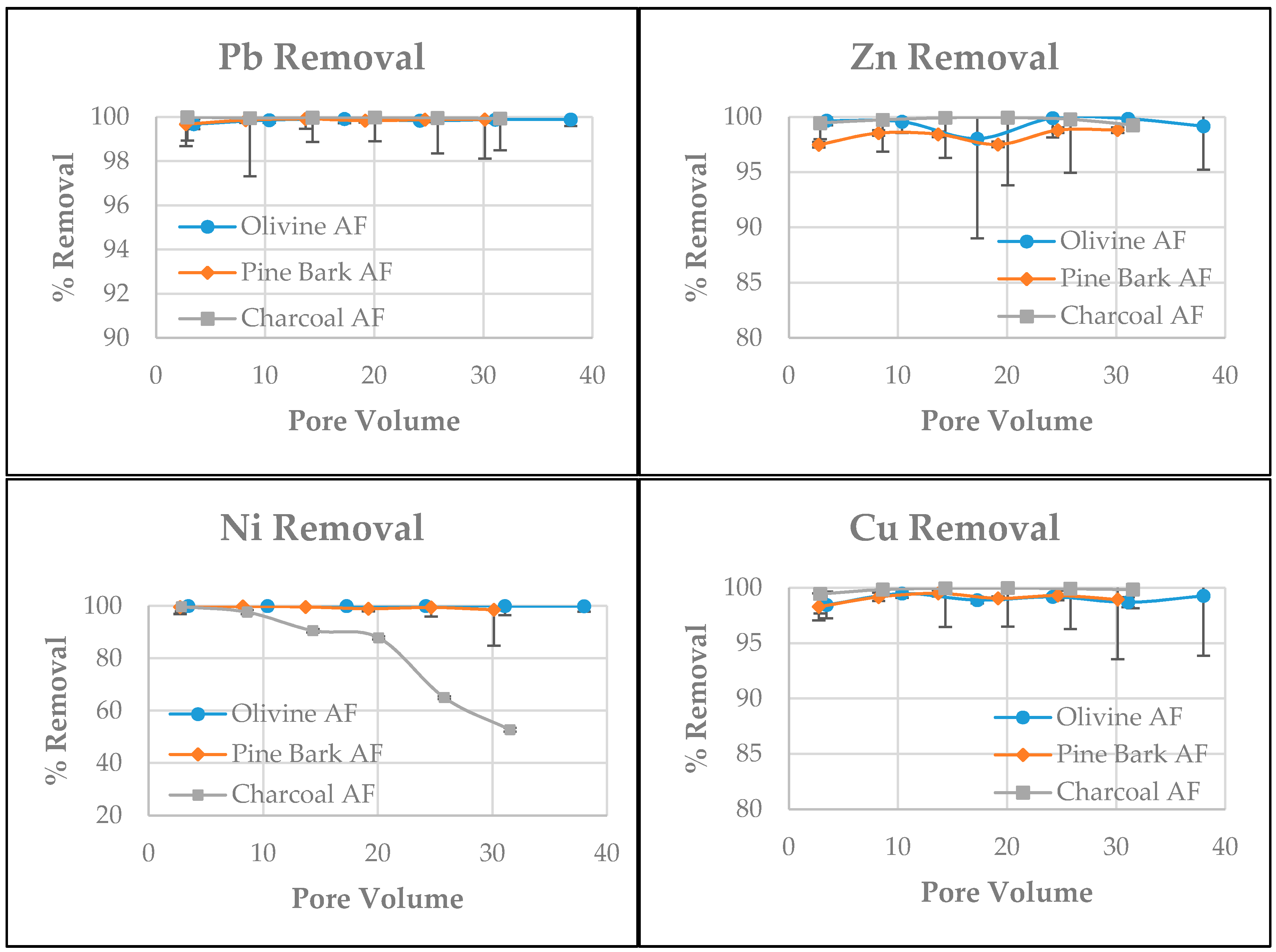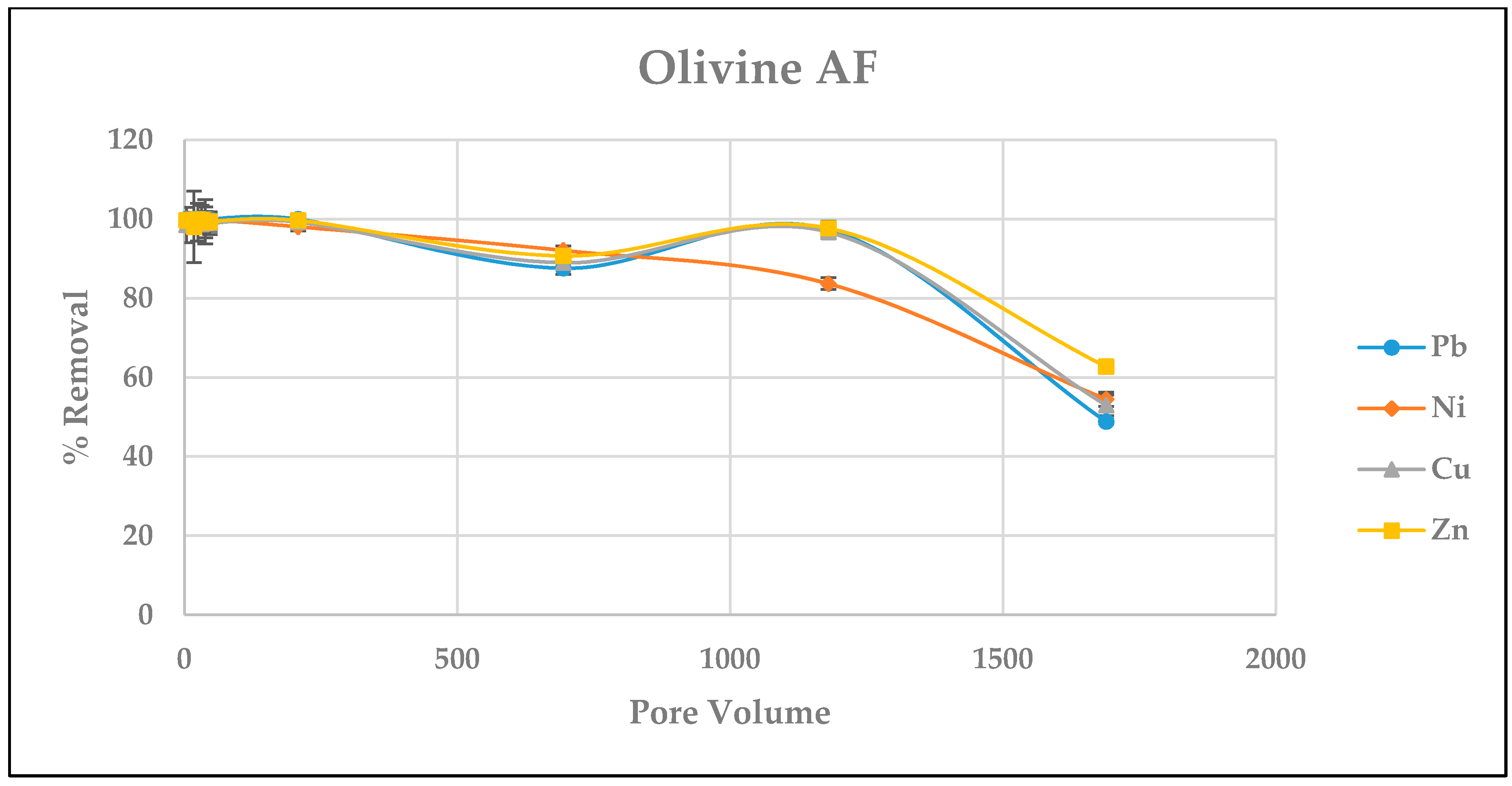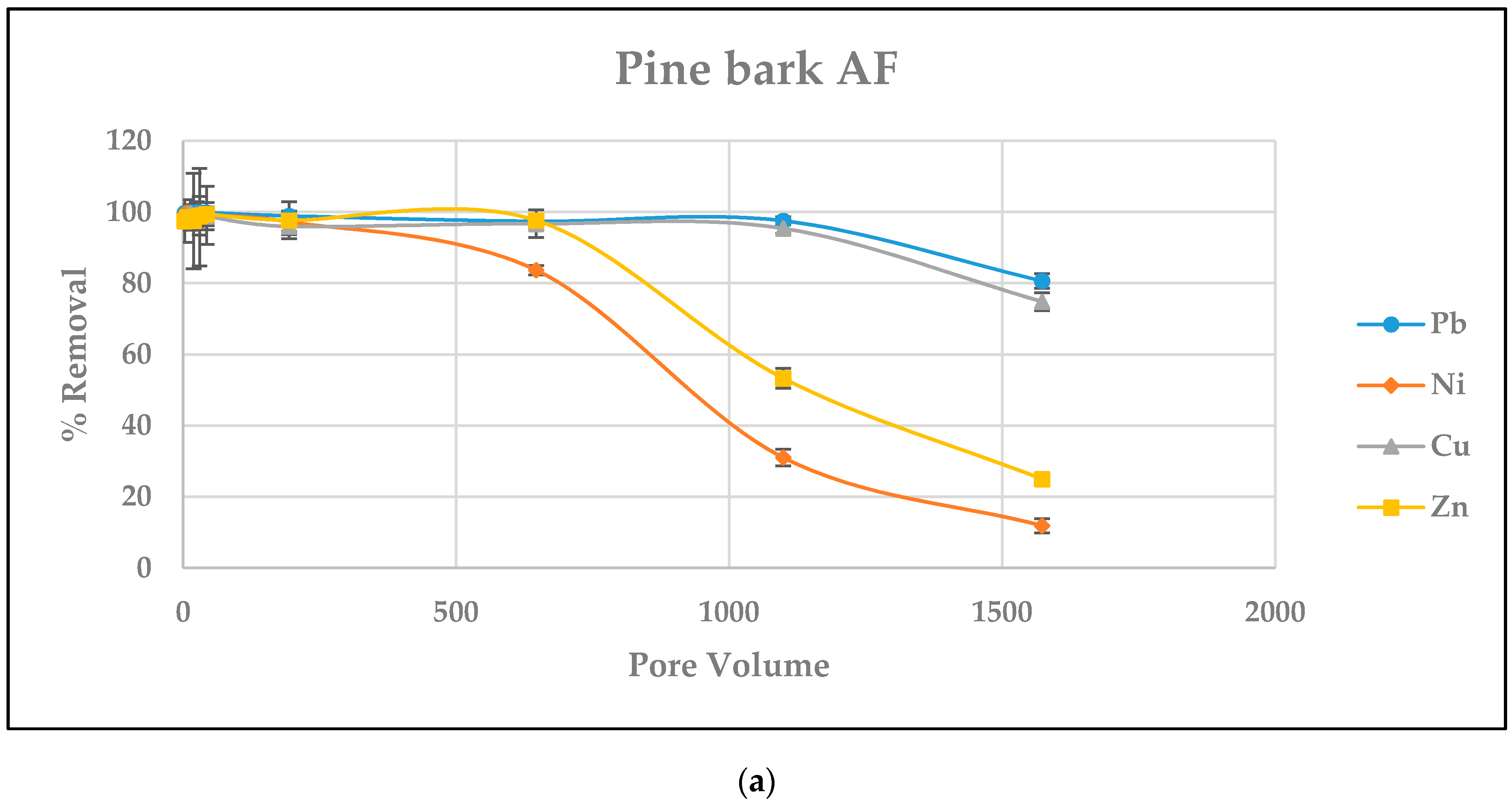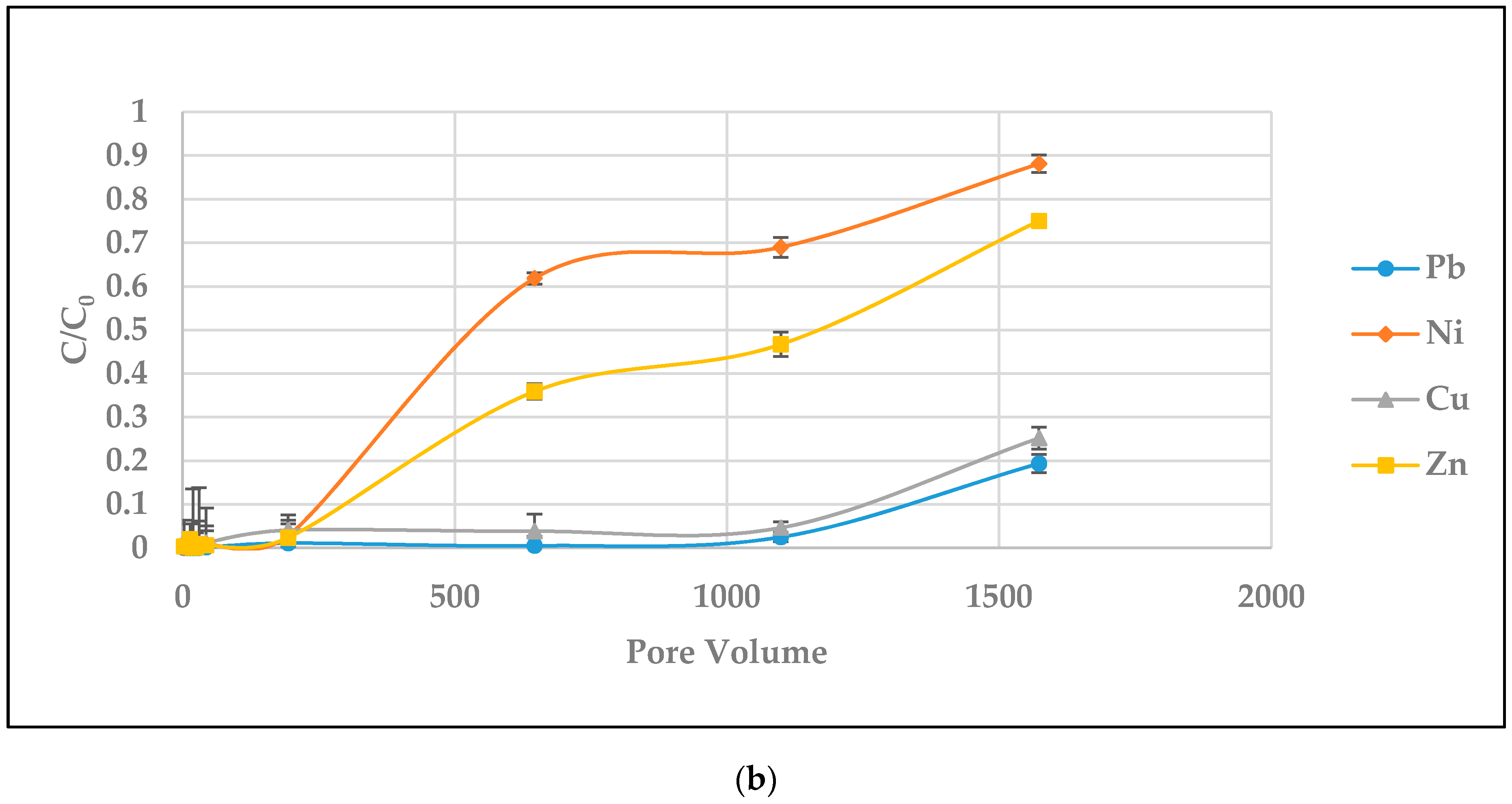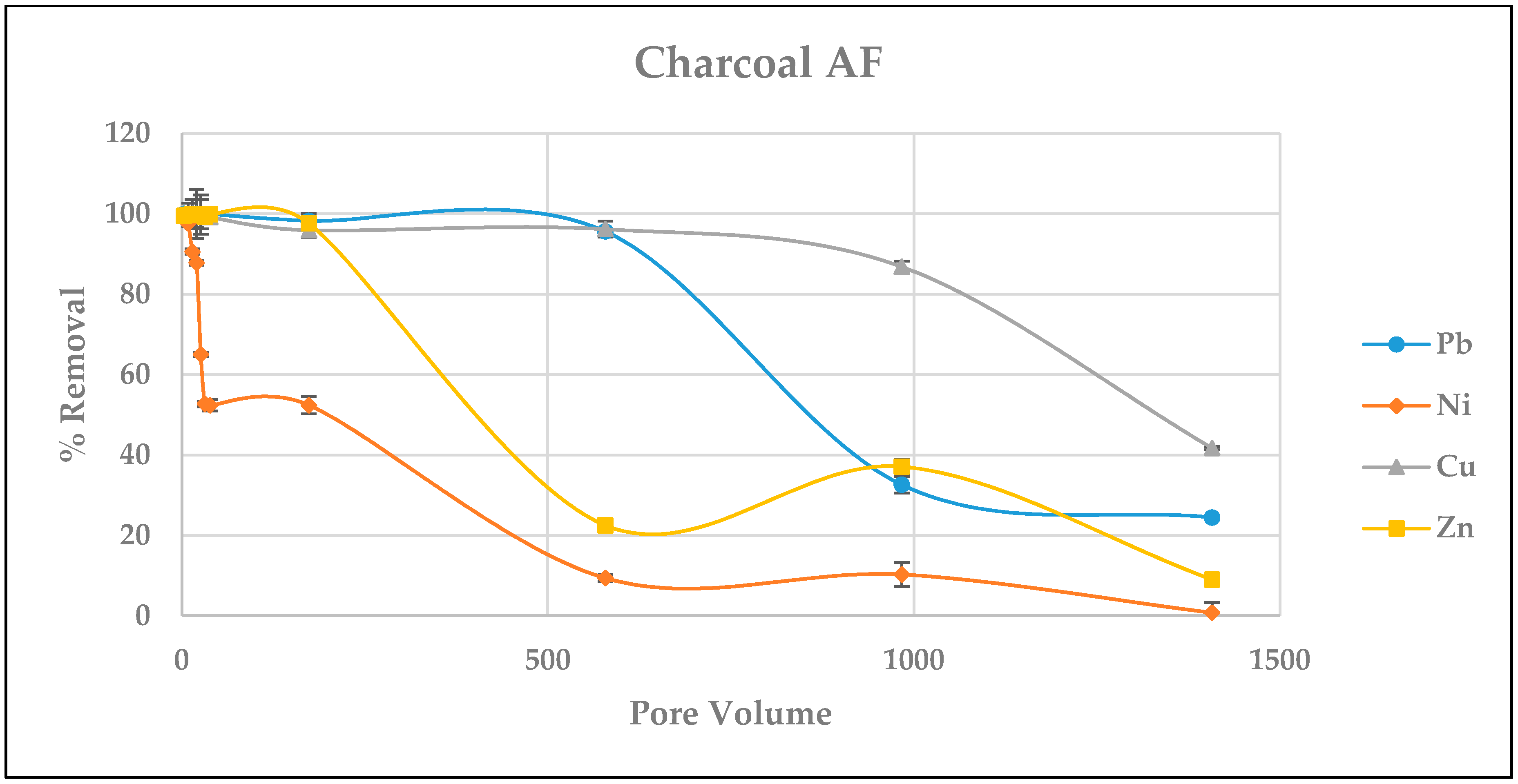2.1. Adsorbent Materials
All the adsorbent materials and the sand (
Table 1) were obtained by commercial suppliers locally. The granulated activated charcoal (extracted from anthracite coal) was a Sigma Aldrich AS product (Oslo, Norway), the sand was manufactured by Rådasand AB (Lidköping, Sweden), the pine bark
Pinus Sylvestris was provided by Nittedal Torvindrustrie AS (Bjørkåsen, Norway), and the olivine was supplied by Sibelco Nordic AS (Rud, Norway) and belongs to the Blueguard
® series. Charcoal and olivine were used without any chemical processing or modification. While, pine bark was sieved <4 mm particle size prior to use in order to favor water retention. The adsorbents were placed in pilot scale columns with clean quartz sand, which was selected for its uniform particle size and little or no background contamination. Therefore, the influence of the sand on the hydraulic conductivity and removal performance was assumed homogeneous throughout the study.
2.2. Column Tests
The adsorbents were tested for removal of four dissolved metals (Cu, Pb, Ni, and Zn) commonly found in urban and highway runoff and of environmental concern for official authorities due to their toxicity towards the biota in the receiving water bodies. For the column tests, synthetic stormwater was prepared in a large tank (1 m
3) by mixing tap water with a stock solution containing the metals. Metal chloride salts were used for preparing the stock solution, and were chosen for the additional benefit of simulating salts in stormwater. On the other hand, tap water contains other major ions (Na
+, Ca
2+, etc.), which makes it a realistic surrogate for actual stormwater (
Table 2). The target metals were added in a quantity to achieve intended concentration of 1 mg/L for each metal in the 1 m
3 influent tank. The reason behind this high concentrations was to be able to obtain detectable concentrations in the outflow and early breakthroughs because high adsorption was expected in the filter based on prior batch tests [
17]. The pH of the synthetic stormwater was approx. 7.5, which is similar to values observed in local urban runoff.
Plexiglas columns with 45 cm length and 10 cm diameter were constructed and used in the study. The columns were filled with 35 cm sand overlying 5 cm of adsorbent (see
Figure 1). Adsorbent placement at the bottom will protect the material from eventual frost and erosion. In addition, bottom placement for pine bark means less oxidation problems as lower zones will remain wetter with lower O
2 availability. The length (40 cm) represents minimum recommended depth for bioretention facilities in Norwegian climate [
18], where these filters might potentially be used.
Three columns were set up for each filter media including a control column that was packed only with sand. All columns were operated at room temperature (20 ± 2 °C) and the tap water used to produce the synthetic stormwater was at 8 ± 2 °C. Multichannel peristaltic pumps with variable flow were used for pumping the synthetic stormwater. The flow rates were based on the saturated hydraulic conductivity (K
sat) of each filter, which has been investigated separately [
19]. Therefore, full infiltration at the largest possible inflow rate was intended with no visible ponding water.
The study was divided in two phases. In the first phase flow rates, supplied by the peristaltic pumps, were controlled and set at the K
sat of each filter. The objective was to verify the adsorption capacity of the filters under high hydraulic loads, specifically under the largest inflow rate that is expected to not generate water ponding. The experimental columns were continuously run for approx. 14 h, and each column received a water volume of approx. 50 L (liquid to solid ratio LS = 11). After passing this volume of water, one of the two duplicate columns for each media was taken aside to study the effect of road salt on the desorption of already immobilized metals. For the salt experiment, the columns were initially fed with approx. 50 L (LS = 11) of plain tap water, and then with the same amount of a solution composed of tap water with 1 g/L NaCl. The concentration of NaCl was based on common concentrations found in highway stormwater in Norway, similar to the value adopted by previous studies [
20]. In the second phase, long-term operation was the objective, and the study continued in each of the remaining columns for 2.5 months (
Table 3). Samples were collected biweekly from the effluents of every column and analyzed for the target metals. After the collection, pH and electroconductivity of the samples were measured, then samples were filtered through 0.45 µm pore membrane filters for analyzing dissolved fraction of the studied target metals, and preserved with 0.1 M HNO
3 acid. Samples were stored at 4 °C until the analysis with a high resolution inductive coupled plasma HR-ICP-MS instrument from Thermo Fisher Scientific AS (Oslo, Norway). Each individual sample was scanned three times and the results were corrected for blank samples. The quantification detection limits for Ni, Zn, Cu and Pb was 0.015, 0.025, 0.03, and 0.002 µg/L, respectively.
Similar column studies of metal adsorption and nutrient removal are found in the literature (
Table 4). In this study, long-term data was needed to explore the exhaustion capacity of the studied filters because input concentrations were low in comparison to the other studies. On the other hand, high hydraulic rates were used to study the removal capacity of these filters under intense inflow rates with expected lower contact times with the filter.
2.3. Hydrological Perspective
In order to relate the simulated flows back to the dimension of the storm events, the following hydraulic approach is presented. This approach is connected to the first phase of the adsorption study, in which the influent rate was adjusted to match the Ksat of each of the media.
In the laboratory setup (
Figure 1), the column acts as an infiltration based system (P) and the pumped water from the tank represents the urban runoff from impervious surfaces (I). The ratio between impervious to pervious area (I/P) is often used to size such filters [
24,
25]. In areas with a high percentage of impervious surfaces such as roads, sidewalks, roofs, etc., an empirical runoff coefficient (C) close to 1 can be assumed.
Equation (1), which is based on the rational method, allows for calculating the ideal storm intensity (SI) in (mm/h) that will generate the HLR in (mm/h) applied on the columns through the peristaltic pump. For a certain hydraulic load, the intensity of the storm event is indirectly linked to the size of the fictitious catchment feeding the columns (I).
2.4. Expected Service Life
The results from the second phase were used to estimate cumulative adsorption capacities of the different adsorbent amended filters for the target metals under the given conditions. The cumulative adsorption for each metal, q (mg/kg), was obtained from Equation (2).
where Ci is the influent concentration (mg/L), Ce is the effluent concentration (mg/L), Vd is the cumulative volume passed until a certain % removal (L), and M is the amount of material in the filter (kg).
Expected cumulative pollutant retention (mg) was obtained as the product of the area of the filter, density, filter depth, and q at the required removal. Expected pollutant input load (mg/year) was obtained as the product of the average dissolved pollutant concentration measured at local streets, annual precipitation depth, area of the tributary catchment, and a volume capture factor of 0.9, based on international design guidelines. The expected service life (years) was obtained, dividing the expected cumulative pollutant retention at a required removal by the pollutant load expected to be treated by the filtration facility.

